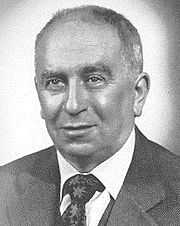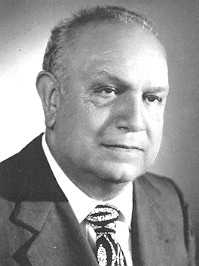Italian general election, 1968
Italian general election, 1968

|
|
|
|
|

|
| Legislative election results map. Light Blue denotes provinces with a Christian Democratic plurality, Red denotes those with a Communist plurality, Gray denotes those with an Autonomist plurality. |
|
General elections were held in Italy on May 19, 1968.[2] Democrazia Cristiana (DC) remained stable around 38% of the votes. They were marked by a victory of the Communist Party (PCI) passing from 25% of 1963 to c. 30% at the Senate, where it presented jointly with the new Italian Socialist Party of Proletarian Unity (PSIUP), which included members of Socialist Party (PSI) which disagreed the latter's alliance with DC. PSIUP gained c. 4.5% at the Chamber. The Socialist Party and the Democratic Socialist Party (PSDI) presented together as the Unified PSI–PSDI, but gained c. 15%, far less than the sum of what the two parties had obtained separatedly in 1963.
Electoral system
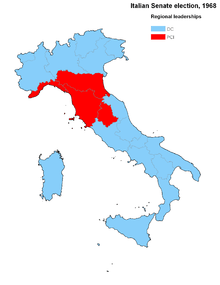
Regional pluralities in Senate
The pure party-list proportional representation had traditionally become the electoral system for the Chamber of Deputies. Italian provinces were united in 32 constituencies, each electing a group of candidates. At constituency level, seats were divided between open lists using the largest remainder method with Imperiali quota. Remaining votes and seats were transferred at national level, where they was divided using the Hare quota, and automatically distributed to best losers into the local lists.
For the Senate, 237 single-seat constituencies were established, even if the assembly had risen to 315 members. The candidates needed a landslide victory of two thirds of votes to be elected, a goal which could be reached only by the German minorities in South Tirol. All remained votes and seats were grouped in party lists and regional constituencies, where a D'Hondt method was used: inside the lists, candidates with the best percentages were elected.
Parties and leaders
Results
The election was a test for the new organization of the socialist area, which was divided between the new revolutionary and Communist-allied Italian Socialist Party of Proletarian Unity and the governmental social-democratic federation between PSI and PSDI. The polls said that the split of the PSIUP in 1964 had not been a purely parliamentary operation, but the reflex of divisions into the leftist electorate. The result shocked the PSI's leadership, causing the sudden sinking of the social-democratic federation, and an alternance of provisional retirements by the government, firstly led by lifetime senator Giovanni Leone and then, through two political crisis, by DC's secretary Mariano Rumor. Unsuccessfully trying to recover its lost leftist electors, the PSI returned to the alliance with the PCI for the regional elections of 1970, so causing another crisis and a new change of premiership, then led by Emilio Colombo, but the government coalition had continuous problems of instability. Influent Giulio Andreotti tried to resurrect the centrist formula in 1972, but he failed, opening the way to the first early election of the republican history.
Chamber of Deputies
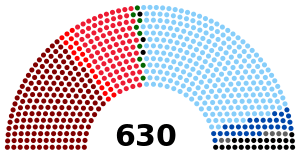
Composition of the Chamber of Deputies after the election.
| Party |
Votes |
% |
Seats |
+/– |
|---|
|
Christian Democracy | 12,437,848 | 39.12 | 266 | +6 |
|
Italian Communist Party | 8,551,347 | 26.90 | 177 | +11 |
|
Unified PSI–PSDI | 4,603,192 | 14.48 | 91 | –29 |
|
Italian Liberal Party | 1,850,650 | 5.82 | 31 | –8 |
|
Italian Socialist Party of Proletarian Unity | 1,414,697 | 4.45 | 23 | New |
|
Italian Social Movement | 1,414,036 | 4.45 | 24 | –3 |
|
Italian Republican Party | 626,533 | 1.97 | 9 | +3 |
|
Italian Democratic Party of Monarchist Unity | 414,507 | 1.30 | 6 | –2 |
|
South Tyrolean People's Party | 152,991 | 0.48 | 3 | – |
|
Social Democracy | 100,212 | 0.32 | 0 | – |
|
Democratic Union for the New Republic | 63,402 | 0.20 | 0 | – |
|
Autonomous Party of Pensioners of Italy | 41,416 | 0.13 | 0 | – |
|
Valdostan Union | 31,557 | 0.10 | 0 | –1 |
|
Others | 87,6740 | 0.28 | 0 | – |
| Invalid/blank votes | 1,211,216 | – | – | – |
| Total | 33,001,644 | 100 | 630 | 0 |
| Registered voters/turnout | 35,566,493 | 92.79 | – | – |
| Source: Ministry of the Interior |
Senate of the Republic
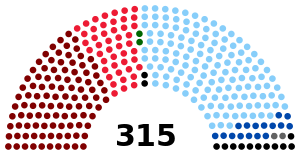
Composition of the Senate after the election.
| Party |
Votes |
% |
Seats |
+/– |
|---|
|
Christian Democracy | 10,972,114 | 38.34 | 135 | +6 |
|
PCI–PSIUP | 8,585,601 | 30.00 | 101 | +17 |
|
Unified PSI–PSDI | 4,354,906 | 15.22 | 46 | –12 |
|
Italian Liberal Party | 1,943,795 | 6.79 | 16 | –2 |
|
Italian Social Movement | 1,304,847 | 4.56 | 11 | –3 |
|
Italian Republican Party | 622,388 | 2.17 | 2 | +2 |
|
Italian Democratic Party of Monarchist Unity | 312,702 | 1.09 | 2 | – |
|
MSI–PDIUM | 292,349 | 1.02 | 0 | –1 |
|
South Tyrolean People's Party | 131,071 | 0.46 | 2 | – |
|
Social Democracy | 36,073 | 0.13 | 0 | New |
|
Valdostan Union | 28,414 | 0.10 | 0 | – |
|
Others | 31,761 | 0.11 | 0 | – |
| Invalid/blank votes | 2,740,176 | – | – | – |
| Total | 30,252,921 | 100 | 315 | 0 |
| Registered voters/turnout | 32,517,638 | 93.04 | – | – |
| Source: Ministry of the Interior |
References




